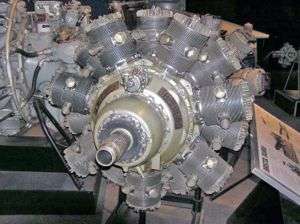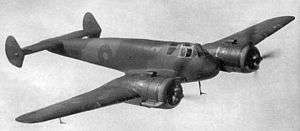Bristol Taurus
| Taurus | |
|---|---|
 | |
| Preserved Bristol Taurus | |
| Type | Piston aircraft engine |
| Manufacturer | Bristol Aeroplane Company |
| First run | November 1936 |
| Major applications | Fairey Albacore Bristol Beaufort |
| Developed from | Bristol Aquila |
The Taurus was a British 14-cylinder two-row radial aircraft engine, produced by the Bristol Engine Company starting in 1936.[1] The Taurus was developed by adding cylinders to the existing Aquila design, creating a powerplant that produced just over 1,000 horsepower (750 kW) with very low weight.
Design and development
Bristol had originally intended to use the Aquila and Perseus as two of its major product lines in the 1930s, but the rapid increase in size and speed of aircraft in the 1930s demanded much larger engines than either of these. The mechanicals from both of these designs were then put into two-row configurations to develop much larger engines, the Aquila becoming the Taurus, and the Perseus becoming the Hercules.
The Taurus was a sleeve valve design, resulting in an extraordinarily uncluttered exterior and very low mechanical noise. It offered high power with a relatively low weight, starting from 1,015 hp (760 kW) in the earliest versions. It was also compact, with a diameter of 46 inches (1170 mm) which made it attractive to fighter designers. Unfortunately, the engine has also been described as "notoriously troublesome", with protracted development and a slow growth in rated power. After several years of development, power had been increased from 1,015 hp (760 kW) to only 1,130 hp (840 kW). As the most important applications of this engine were in aircraft that flew at low altitude, engine development efforts focussed on low-altitude performance.
The first Taurus engines were delivered just before World War II began and found some use primarily in the Fairey Albacore and Bristol's own Beaufort torpedo bomber. Starting from April 1940, it was suggested to replace the Taurus engines of the latter by the famous Pratt & Whitney R-1830 Twin Wasp, but this change was postponed to the autumn of 1941 while attempts were made to cure the reliability problems of the Taurus, and later had to be temporarily reversed because of shortages of Twin Wasp engines. The Twin Wasp was, however, strongly preferred, especially for overseas postings, because of its much greater reliability. In later models of the Taurus engine the reliability problems were mostly cured by a change in the cylinder manufacturing process, although the engine kept a poor reputation, and in the Albacore the Taurus engine was retained until the end of that aircraft's production in 1943.[2]
There were no other operational applications of the Taurus engine, because its initial reliability problems discouraged the development of Taurus-powered aircraft, and because later-war combat aircraft demanded more powerful engines. Its production lines were closed down in favour of the Hercules engine.
Variants
- Taurus II
- 1940 1110 hp at 3100 rpm with 4.25 lb boost @ 4000 ft.[3]
- Taurus III
- 1060 hp.
- Taurus VI
- 1130 hp.
- Taurus XII
- 1940 1130 hp at 3100 rpm with 4.75 lb boost @ 3500 ft. Supercharger ratio decreased, impeller diameter increased.
- Taurus XVI
- 1940 1130 hp.
- Taurus XX
- Trials engine only, one built.
Applications
Note:[4]

Specifications (Taurus II)
Data from Lumsden.[5]
General characteristics
- Type: 14-cylinder, two-row, supercharged, air-cooled radial engine with dual ignition
- Bore: 5 in (127 mm)
- Stroke: 5.625 in (143 mm)
- Displacement: 1,550 in³ (25.4 L)
- Length: 49.2 in (1,250 mm)
- Diameter: 46.25 in (1,175 mm)
- Dry weight: 1,301 lb (590 kg)
Components
- Valvetrain: Sleeve valve
- Supercharger: Single-speed centrifugal type supercharger
- Fuel system: Claudel-Hobson carburettor
- Fuel type: 87 Octane petrol
- Cooling system: Air-cooled
- Reduction gear: Farman epicyclic gearing, 0.444:1
Performance
- Power output:
- 1,140 hp (850 kW) at 3,225 rpm for takeoff
- 1,050 hp (783 kW) at 3,225 rpm at 5,000 ft (1,520 m)
- Specific power: 0.68 hp/in³ (30.83 kW/l)
- Compression ratio: 7.2:1
- Specific fuel consumption: 0.43 lb/(hp·h) (261 g/(kW·h))
- Power-to-weight ratio: 0.81 hp/lb (1.33 kW/kg)
See also
- Related development
- Related lists
References
| Wikimedia Commons has media related to Bristol Taurus. |
Notes
Bibliography
- Gunston, Bill. World Encyclopedia of Aero Engines. Cambridge, England. Patrick Stephens Limited, 1989. ISBN 1-85260-163-9
- Lumsden, Alec. British Piston Engines and their Aircraft. Marlborough, Wiltshire: Airlife Publishing, 2003. ISBN 1-85310-294-6.